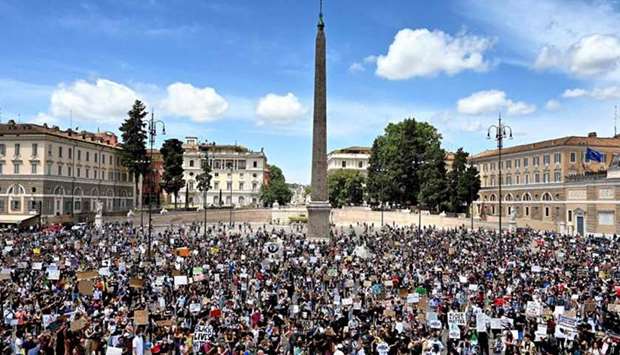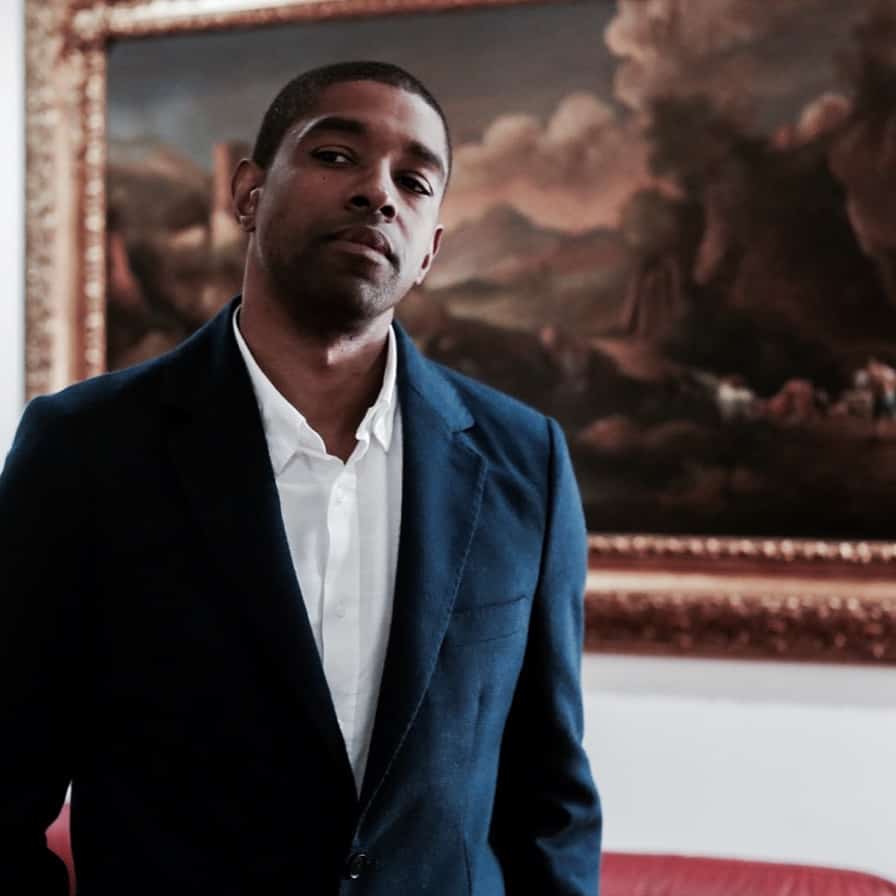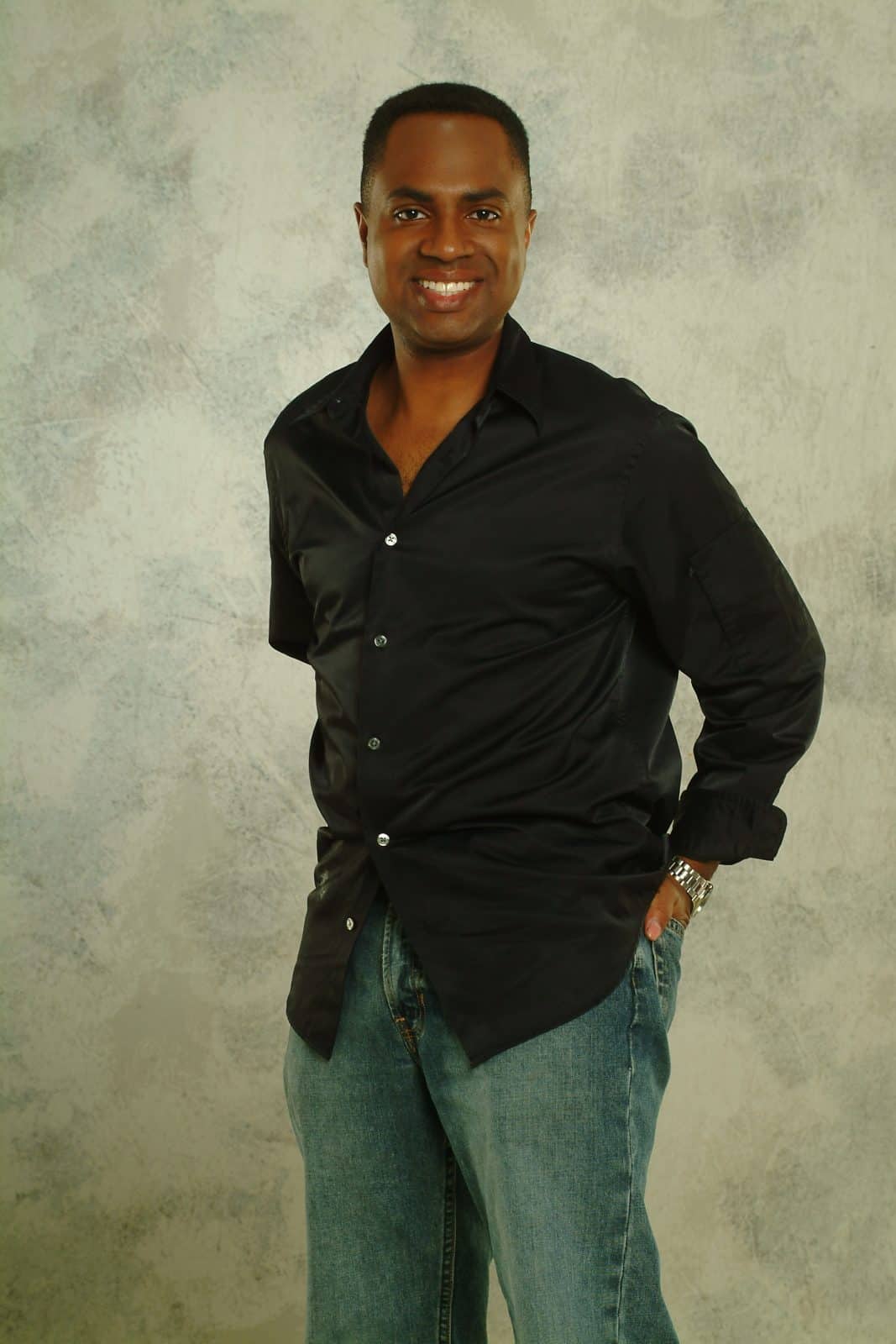Black Lives Matter movement hits Rome and African Americans here join the chorus

They yelled and chanted his name. They knelt for 8 minutes and 46 seconds. They held banners reading, “LIFE IS NOT WHITE PRIVILEGE” and “SILENCE IS VIOLENCE.” Three thousand strong stood and knelt, yelled and chanted, social distancing be damned.
It wasn’t in Minneapolis. It wasn’t in New York. It wasn’t in San Francisco.
It was here in Rome. More than 5,000 miles away from a murder that sent the United States up in flames, Black Lives Matter didn’t need a translator. More than 3,000 people from all over Rome filled Piazza del Popolo to honor George Floyd and call attention to what isn’t just a black problem. It’s not just a white problem.
It’s a global problem.
It’s a problem here.
It wasn’t lost on me that Rome’s movement chose Piazza del Popolo to hold Sunday’s Black Lives Matter rally. It was in this massive square in the north end of town where one of Rome’s last public executions took place. In 1826, two freemasons named Angelo Taghini and Leonida Montanari were beheaded for conspiracy by order of the Catholic Church. George Floyd was executed over a $20 counterfeit bill.
The western world has come a long way in 200 years, hasn’t it?
I didn’t go to the rally and kicked myself all day Monday after reading about the turnout, how peaceful it was and the impact it had on the city. Racism in Rome and Italy definitely exists.
However, it isn’t nearly as obvious as in the U.S. where under Hair Hitler all the knuckle-dragging rednecks have emerged from their swamps to drop N-bombs in public and march under swastika flags. I’ve lived in Rome six years and have never met a racist. Only one person has made a racist comment in my presence. It was about Pres. Obama: “A black man shouldn’t be president of a white country.” But this racist split his life between Australia and Italy, and he’s the only racist I’ve met from either place.
Black Lives Matter neeeded in Italy
Still, racism in Italy is obvious. Just read the sports dailies. So many racist chants and incidents occur in soccer stadiums I think I’m living in Mississippi in the 1930s. Some politicians have tried making immigration almost a capital offense.
When I talk to blacks here I get mixed messages. One friend a few years ago was a journeyman pro soccer goalie from Nigeria. He played for different lower-division teams in the Rome area. He said in nine years he had only one incident, when a group of young drunks passed him in a car near Rome’s nightclub zone late at night and dropped an N-bomb on him.
Then again, an East African woman who worked in her country’s embassy and was fluent in Italian called to inquire about a vacant apartment. When she showed up just a few minutes later the landlord saw her and said it was no longer available.
I’m also not black which changes the scope. I reached out to a couple of African-Americans who have lived here and had different experiences. Like me, Yonv Joseph has been in Rome six years and attends Expats Living in Rome Meetup group events. He’s a music student, actor and composer. A native of Jacksonville, Fla., one of the most Deep South cities in the state, he’s written a TV series called “Bruh” (Black Roman Unapologetic Here), (https://www.yonvjoseph.com/bruh) about being black in Rome.
“With the police everywhere they treat us differently,” Joseph said. “Just the intensity might be different.”

He remembers one time returning to Rome by train. He arrived at Termini station late and a group of policemen were talking and looking at him.
“Something was about to happen,” he said. “One started to approach me until my girlfriend at the time popped up. They said, ‘Oh, he’s with you.’ She said, ‘No. We’re together.’ Then they backed off. What’s that supposed to mean?”
Another time he was in the student neighborhood of San Lorenzo attending a concert rehearsal. Two plainclothes cops stopped and grabbed him.
“I thought it was two random people ready to fight so I turned around and hit both of them,” he said. “They grabbed me for no reason. They didn’t say a word as to being a police officer. Nothing. So I dropped my stuff and we got into a fight.”
They were in front of a restaurant and when an employee came out to check the disturbance, the men identified themselves as plainclothes cops. Then they started arguing.
“They were like, ‘Show some identification,’” Joseph said. “I reluctantly showed it to them. And they said, ‘Oh, he’s American.’ I was like, ‘And if I wasn’t?’”
Philly native has no problems
That’s a common theme here. Gaylord Swaby was my running mate from my old Testaccio neighborhood not far from the Circus Maximus, where they held the chariot races. He works for a computer company and to say he’s taken advantage of his ability to work remotely is like saying Ferdinand Magellan took advantage of oceans.
Swaby, 48, a Philadelphia native, has lived in Rome, Berlin, Bucharest, London, Cairo, Manila, Caracas and Basel and Geneva in Switzerland. I caught up with him in his current outpost, Pasadena, Calif., where he’s getting the full George Floyd coverage 24-7.
I asked him how the police treat him in the U.S. compared to Rome.
“It’s completely different,” he said. “I would say in Rome how they treat American blacks as opposed to African blacks is also different. When I’m in the main train station or airport, I do get asked for ID. Once I show ID, the police always leave me alone. I don’t know if it would be the same way for Africans. Maybe because they’re looking for illegal immigrants.”

He said the police are different to him all over Europe.
“Police in Germany are even nicer and more polite and professional,” he said. “They’re very nice people. When they come to your door you don’t worry about them beating the crap out of you. They don’t touch you. They will come out and check out the scene. If they need something particular, they’ll call in a specialist or backup to help them.”
Joseph went to Sunday’s Black Lives Matter rally, which, ironically, came a day after Circus Maximus held a far right rally protesting the government’s coronavirus response. That rally had 2,000 people but quickly dissipated to a couple hundred and its hopes of attracting far right soccer fans was a major flop.
Black Lives Matter had rallies in about a half dozen cities all over Italy.
“The first thing I liked was the solidarity,” Joseph said. “A lot of people questioned, seriously, if it was right for other countries to protest or speak out against what happened in the U.S. Yes, if you go back to the old quote, ‘Injustice anywhere is a threat everywhere.’ It was good to see everyone together on their own accord.”
Italy has fascist history
Rome’s rally wasn’t just about George Floyd. It also reflected Italian fascism dating back to the Ancient Roman Empire and the time of Mussolini. Roman armies returned from conquests and turned foreign prisoners into slaves. Every time I go to Rome’s Jewish Ghetto I recall the details from Oct. 16, 1943 when 1,259 Jews were hauled off to the Auschwitz death camp. Only 16 returned.
Francesca Conti is an adjunct professor of sociology at the American University of Rome. The British-educated Rome native has an emphasis on immigration and wasn’t surprised by Sunday’s huge turnout.
“In fascism one of the key ideas within that type of totalitarian ideology was that there was a people, a race, similar to what Hitler did,” Conti said. “There was a kind of emphasis that we share within one another because we belong in the same place. There was an emphasis on us versus them. Any outsider would be considered less important than an Italian.”

Discrimination in Italy has been around for 2,000 years. The industrialized North still hates the agricultural South. Tuscans hated Romans. It continues today with soccer fan bases. Being the capital and the center of art, education and fashion, Rome has always been more racially diverse.
“But that doesn’t mean it’s not free of any discrimination and racism,” Conti said. “In fact, the elite, by definition, was always white.”
But when immigration became huge in the 1990s, the voices changed. First came immigrants from Eastern Europe, many of whom looked Italian and were considered “invisible immigrants.” Then came the second wave from North and West Africa, Bangladesh. They became easier to spot.
“That started a whole new wave of discrimination and racism in a more kind of traditional sense of what you’re used to in the United States,” she said.
When Conti grew up, she knew only one black student in her neighborhood. His parents worked for the World Food Program, one of Rome’s biggest United Nations’ organizations. Yes, she said, it does make a difference where the black person is from.
“For the Italian, say the average mind, black people come from Africa so we tend to think they are immigrants coming from a poor country,” she said. “If they come with an American accent and act American, they’re rich. And you never discriminate against the rich.”
Italian laws on immigration
Italian laws are still stacked against immigrants. You can only become an Italian citizen if you have connection with Italian blood or are from outside Europe and been a legal resident for at least 10 years. If you are born in Italy to immigrant parents, you are not a citizen until you’re 18 and even then you must prove you haven’t left the country for long periods.
Mario Balotelli, one of Italy’s greatest offensive soccer talents the last 10 years, was born in Sicily to Ghanian parents and given up to foster parents. A middle-class couple raised him in a small town in Lombardy, and Balotelli has faced monkey sounds and racist chants in stadiums all over Italy.

“The death of (Floyd) has really reopened the conversation that was never really silenced,” Conti said. “In Italy we have some movements by people from second-generation backgrounds, children of immigrants, that are demanding and lobbying and trying all they can to get reform on the citizenship legislation.
“Government never really wanted to respond to that because when anti-immigration became very popular, then it was clear, even for a left-wing party, that if you try to change the citizenship legislation you will lose votes.”
I have not seen the George Floyd video. I won’t. I can’t. I’ve been so full of bile from Mango Mussolini’s administration in the White House, the news accounts were enough to make me nauseous. Joseph has a podcast (https://www.yonvjoseph.com/podcast) in which he interviewed a black cop in California who urged him to see the video.
“It was like watching somebody drown,” he said. “It’s not because he can’t swim but because the lifeguard is holding him underwater.”
Joseph knew the different narratives and the excuses. He wanted to see what possible excuse could come from a cop choking a black man to death in clear daylight.
“While watching it I was hoping for a different outcome,” he said. “You hear people screaming and pleading. I’m looking at the police officers and not just the one with the knee on the neck but the other one on camera. I’m going, ‘You’re going to have to say something. There’s absolutely no way you’re going to let this man choke this guy to death who’s already handcuffed, on his stomach, in custody. You’re not going to let this happen.’
“Then he goes limp. And I go limp.”
Swaby comes from a city where on Wednesday they removed the statue of Frank Rizzo, the ex-Philadelphia mayor and police chief famous in the ’70s for telling his citizens “Vote white.” Swaby brushes off promises of police reform and says the protesting should continue.
“I’m all for burning it all down,” he said. “The police have had many years and many opportunities to fix it. What’s more, I don’t think it’s entirely a black people problem. It’s more than 50 percent a white people problem, in America in particular. You bring black people in as slaves, you free them and leave them economically destitute then you beat them and shoot them, then you lie about it and now we’re supposed to believe you’re going to do the right thing?

“Nope. The trust is gone. We don’t trust you’re going to do anything anymore. It’s up to white America to fix it or live with those images.”
I’ve never met a racist here
What bothers me most is of the 107 countries I’ve visited, the U.S. remains the most racist I’ve ever been. Yes, I know of the human rights violations among ethnic groups in rural China. When I was in Ecuador, native Indians couldn’t own land. In February I was in Saudi Arabia where religions besides Islam are considered illegal (although have become more tolerated).
But none of these countries had police kill 104 unarmed blacks in 2015. None has a president who says there are good people on the Alt Right. And I don’t remember any minority anywhere else suffering the same fate as George Floyd, whose name and lifeless image will live with all of us forever. Four years after quarterback Colin Kaepernick knelt during the national anthem, right-wing America hasn’t learned. They wrap themselves too much in the flag to read that he was not protesting the military. He was not protesting the government. He was not protesting God.
He was protesting police brutality against blacks. Four years later, a Minneapolis cop with 17 prior citations for excessive force mocked Kaepernick’s gesture by kneeling on a black man’s neck. The cop didn’t just kill an image.
He killed a man.
This is why people like Joseph want to see answers come out of the Black Lives Matter protest he experienced and the others from around the world.
“They have to push on it,” he said. “Speaking from an American point of view, 1619 was when the first slaves were brought to the States. It’s been 401 years and in 401 years these people, the oppressors, had a goal and they’ve been executing it for 400-plus years. It’s going to take more than a weekend, two weeks, a month, whatever, in order to take this proverbial knee off our necks.”


June 11, 2020 @ 6:27 am
Excellent. Excellent. Excellent.
Thank you for the facts. The humanity. The voices.
There is far more racism in Italy than meets the eye…especially in the wonton abuse of our African women for Italian male sexual fantasies…So are men being shot in the streets? No. But the objectification and destruction of their shared humanity is palpable. Even here.
June 16, 2020 @ 4:14 pm
I was waiting for a bus in a small Lombardian village when an African woman came and stood in line. A man who had been waiting like anyone else started leering at her in such a disgusting way. I lacked the language to call him out in Italian or to ask if she was Ok. I ended up just looking and gesturing at him in a disgusted way.
I’ve never seen anything like that in the US.